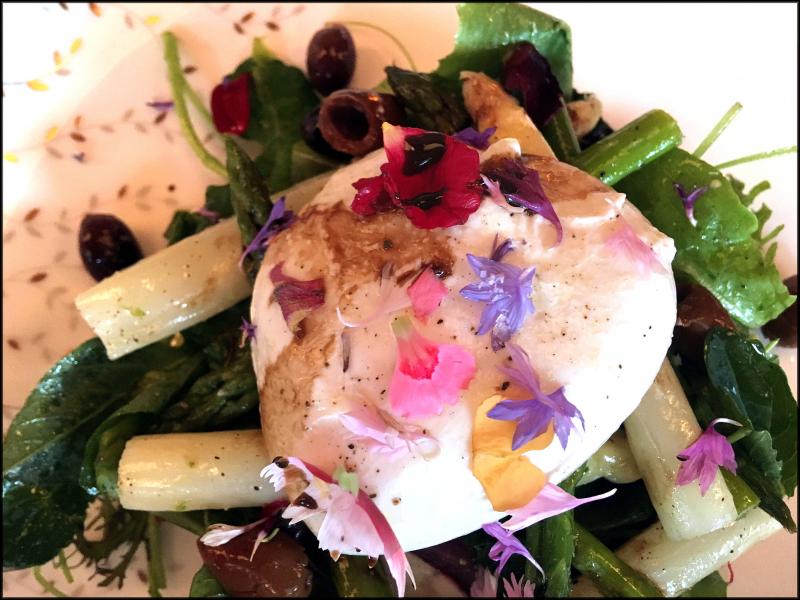Differences in mozzarella, burrata
One ingredient that's been appearing with increasing regularity in trendy recipes and restaurant menus is burrata cheese. Originally, burrata was created as a way to salvage scraps of mozzarella cheese left over once the tender balls were formed. Both are types of semi-soft Italian cheese, with a key difference.
Mozzarella, which originated in southern Italy, is often described as a pulled cheese. Made from either cow's milk (more common) or water buffalo milk (more difficult to find), fresh mozzarella is quite different from the plastic-wrapped balls or grated shreds sold in the grocery store. Those are usually "low-moisture" mozzarella, with less than 50 percent moisture content and lots of preservatives.
Fresh mozzarella is soft, moist and highly perishable. To make mozzarella, raw milk is pasteurized and then treated with rennet so it coagulates into curds. These are then mixed with hot water and strung or spun into long ropes of cheese. Once the desired consistency is reached, the cheese is formed into balls and transferred into a cold-water bath to maintain their shape.
Mozzarella sold in containers with its liquid (sometimes called "latte") or directly from the maker should be enjoyed within a few days. Its flavor will be slightly tangy and salty with a rich, milky essence. Whether sprinkled on pizza, tossed with tomatoes and Balsamic vinegar, or melted on hot pasta, the creamy texture and delicate flavor are unmistakable.
Burrata begins as mozzarella (and is rumored to have been developed as a way to salvage leftover scraps of mozzarella), but the center of the ball of cheese is left as a hollow pouch. This is filled with soft, stringy, uncooked cheese curds mixed with cream, which ferments slightly to deliver a stronger flavor than mozzarella. The name burrata translates as "buttered" which is an apt description of its silky center. When the pouch of burrata is sliced open, its creamy interior spills out, delivering an impossibly rich coating over your salad greens, roasted vegetables or pasta. Typically served at room temperature, burrata needs to be eaten within 48 hours to be fully appreciated.
How do you choose which of these two fresh cheeses will work best in your recipe? If you want the cheese to melt over a cooked dish such as pizza, baked ziti or lasagna, select mozzarella. It is better suited to grating and will brown to a lovely golden shade as it melts. If you cook burrata, it will lose its signature texture contrast of milky center and tender exterior. Save this more costly cheese to savor as the centerpiece of a dish.
In the photo is an interesting burrata salad. Baby greens are topped with two layers of asparagus, one green and one white. A generous ball of burrata sits on top, and the entire dish is garnished with olives, a Balsamic drizzle and colorful petals of edible flowers. When my fork pierced the cheese, its milky center covered the layers in perfect contrast to the salty olives and tangy vinegar.
A variation on that recipe is one featuring heirloom tomatoes and colorful baby beets dressed with olive oil and white Balsamic with a garnish of shredded basil. The lemon pasta recipe can be made with mozzarella or burrata, but I prefer the latter, set in the center of the lemony pasta. You'll find many recipes that call for melting or cooking burrata (in omelettes, on pizza or stirred into hot pasta), but I would use fresh mozzarella in those dishes, reserving the rich, creamy burrata to share its secrets with your first bite.
Tomato & Beet Burrata Salad
1 lb baby beets
1 lb ripe tomatoes*
1 1/2 C arugula
2 balls burrata cheese
salt & pepper, to taste
1 T olive oil
1 T white Balsamic vinegar
1 T shredded basil leaves
Remove the beet greens and reserve for another use. Quarter beets and place in a steamer basket over rapidly boiling water. Cover and cook until tender, about 15 minutes. Allow beets to cool; remove and discard skins.
Scatter the arugula on a serving platter. Quarter tomatoes and arrange on arugula, alternating with beets. Place the burrata balls in the center of the plate. Season to taste with salt and pepper. Whisk together oil and vinegar; drizzle over the platter. Garnish with basil. Yield: 2 to 4 servings. *Note: choose a variety of colors and types.
Lemon Burrata Pasta
1/2 lb ziti
2 T olive oil
1 minced shallot
3 minced garlic cloves
zest of 1 lemon
2 T lemon juice
4 C baby arugula
salt & pepper, to taste
3 balls burrata cheese
red pepper flakes
Cook pasta to al dente texture, according to package directions. Heat olive oil in a large skillet over medium. Add shallot and garlic; sauté until fragrant, about 2 minutes. Add lemon zest. Drain pasta, reserving 1/2 C pasta water. Add pasta to skillet along with lemon juice, arugula and pasta water. Toss to combine and cook just until the arugula is wilted. Season to taste with salt and pepper. Divide pasta into serving bowls and top each with a ball of burrata. Garnish with red pepper flakes. Yield: 3 to 4 servings.
Lentil Burrata Salad
1 T olive oil
1 diced red onion
1 diced carrot
1 diced celery stalk
2 minced garlic cloves
1 C dry lentils
1/2 t salt
3 C vegetable broth
2 T olive oil
1 T rice wine vinegar
1 T lemon juice
1 t snipped chives
1 T parsley
salt & pepper, to taste
3 burrata balls
Heat olive oil in a saucepan over medium. Add onion, carrot and celery; sauté until tender, about 4 minutes. Add garlic and cook until fragrant, about 2 minutes. Add lentils, salt and vegetable broth. Cover and simmer until tender, but not mushy, about 20 minutes. Drain lentils and place in a serving bowl. Whisk together oil, vinegar, parsley and chives. Pour over lentils and toss gently to combine. Season to taste with salt and pepper. To serve, place one burrata ball on each plate of lentils. Yield: 3 to 4 servings.






















































